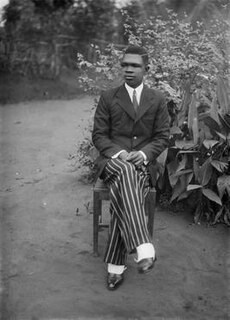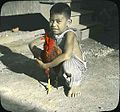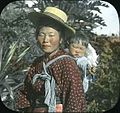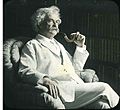
The magic lantern, also known by its Latin name laterna magica, is an early type of image projector that used pictures—paintings, prints, or photographs—on transparent plates, one or more lenses, and a light source. Because a single lens inverts an image projected through it, slides were inserted upside down in the magic lantern, rendering the projected image correctly oriented.

The Autochrome Lumière was an early color photography process patented in 1903 by the Lumière brothers in France and first marketed in 1907. Autochrome was an additive color "mosaic screen plate" process. It was the principal color photography process in use before the advent of subtractive color film in the mid-1930s.

Sergey Mikhaylovich Prokudin-Gorsky was a chemist and photographer of the Russian Empire. He is best known for his pioneering work in color photography and his effort to document early 20th-century Russia.

The Bernice Pauahi Bishop Museum, designated the Hawaiʻi State Museum of Natural and Cultural History, is a museum of history and science in the historic Kalihi district of Honolulu on the Hawaiian island of Oʻahu. Founded in 1889, it is the largest museum in Hawaiʻi and has the world's largest collection of Polynesian cultural artifacts and natural history specimens. Besides the comprehensive exhibits of Hawaiiana, the museum's total holding of natural history specimens exceeds 24 million, of which the entomological collection alone represents more than 13.5 million specimens. The Index Herbariorum code assigned to Herbarium Pacificum of this museum is BISH and this abbreviation is used when citing housed herbarium specimens.

Eugène Atget was a French flâneur and a pioneer of documentary photography, noted for his determination to document all of the architecture and street scenes of Paris before their disappearance to modernization. Most of his photographs were first published by Berenice Abbott after his death. Though he sold his work to artists and craftspeople, and became an inspiration for the surrealists, he did not live to see the wide acclaim his work would eventually receive.

Hand-colouring refers to any method of manually adding colour to a monochrome photograph, generally either to heighten the realism of the image or for artistic purposes. Hand-colouring is also known as hand painting or overpainting.

Huc-Mazelet Luquiens (1881–1961) was an American printmaker, painter and art educator who was born June 30, 1881 in Massachusetts to Jules Luquiens a French-speaking Swiss and Emma Clark who was born in Ohio.

James J. Williams (1853–1926) was an English-born photographer in the Kingdom of Hawaii. He worked for Menzies Dickson and then bought out Dickson's studio in 1882.

Christian Jacob Hedemann was a Danish mechanical engineer who settled in Hawaii in 1878, where he worked at the Hana Sugar Plantation and the Honolulu Iron Works. He is, however, remembered primarily as an avid amateur photographer who helped found the Hawaiian Camera Club (1889–1893). His photographs of native peoples, landscape, family, and industry offer a unique pictorial record of Hawaii at the end of the 19th century.

Alfred Richard Gurrey Sr. (1852–1944) was an English-born landscape painter who moved to the United States at age 20. In 1900, his employer, Fireman's Fund Insurance Company, transferred him from San Francisco to Hawaii. In Hawaii, he worked as an insurance adjuster and was secretary of the Board of Fire Underwriters of the Territory of Hawaii. Although without formal art training, he painted Hawaiian landscapes and opened an art and antiques store in Honolulu. Gurrey was a member of the Kilohana Art League. In 1916, he retired from the Board of Fire Underwriters and moved to Kauai, where he continued to paint. His son, Alfred Richard Gurrey Jr. (1874–1928) and daughter-in-law, Caroline Haskins Gurrey (1875–1927), were photographers active in Hawaii.

The Kamehameha I statue is an outdoor sculpture by American artist Thomas Ridgeway Gould, cast in 1880 and installed in 1883. It stands in front of the old country courthouse in the town of Kapaʻau, located in North Kohala on the Island of Hawaiʻi. Made of cast brass and painted with lifelike colors, it depicts Kamehameha I, and represents an important cultural and spiritual object for the local community.

Walter Scott Bowman was a prominent professional photographer in Pendleton, Oregon. His work is included in the University of Oregon's Bowman, Moorhouse, Furlong, and Drake collections. Bowman captured well known action shots from the Pendleton Round-Up that are included at the National Cowgirl Hall of Fame. The National Cowboy Museum includes numerous Bowman photographs and postcard images. Bowman photographed events around Umatilla, Oregon including parades, marching bands, railroad scenes, Pendleton High School team pictures, dances, studio portraits and images of Native American. The University of Oregon's Walter S. Bowman photographs collection includes 379 glass-plate negatives, 51 cellulose acetate negatives, and 200 silver gelatin photoprints.

Chansonetta Stanley Emmons (1858–1937) was an American photographer in the 19th and early 20th century. Emmons' photography depicts scenes of domestic life and New England rural landscape. Born December 30, 1858 in the mill town of Kingfield, Maine, the young Chansonetta Stanley grew interested in photography after her brothers' dry-plate printing invention..

Martin John Ridley was an English Victorian/Edwardian photographer based in Bournemouth. Many of his photographs were used to produce picture postcards of the seaside towns and attractions in the South of England. Many of these postcards are still circulating at postcard fairs and acquired by collectors. They are usually identifiable by the initials "MJR" followed by a serial number. Several thousand of his original glass-plate negatives still exist and are being academically catalogued. A large sub-section of these negatives, featuring scenes in Wales, is held by the National Library of Wales in Aberystwyth.

Chief Solomon Osagie Alonge (1911–1994) was a self-taught photographer and pioneer of Nigerian photography. He was the first official photographer for the royal court of Benin City, Nigeria, and a chief in the Iwebo palace society. Alonge's record of Nigerian royalty and social class is one of the most extensive and well-preserved collections from the period.

John Tamatoa Baker, also given as John Timoteo Baker, was a Hawaiian politician, businessman, and rancher who served many political posts in the Kingdom of Hawaii, including Governor of the Island of Hawaii from 1892 to 1893. Baker and his brother became the models for the Kamehameha Statues.

Robert Hoapili Kekaipukaʻala Baker was a Hawaiian ali'i (noble), military officer, courtier, and politician who served many political posts in the Kingdom of Hawaii, including Governor of Maui, Privy Councillor and aide-de-camp to King Kalākaua.
Photo-crayotypes were an artistic process used for the hand-colouring of photographs by the application of crayons and pigments over a photographic impression.

Leigh Richmond Miner (1864–1935) was a photographer in the United States. She was the principal photographer at Hampton Institute and her work appeared throughout the school's extensive publications and publicity materials during the first three decades of the twentieth century. He was photographed by Frances Benjamin Johnston as a part of her celebrated series of early publicity images for the school, appearing in several images teaching art in school classrooms.
The Matson Photo Service, whose founders were G. Eric Matson and his wife Edith, evolved from the American Colony Photo Department that helped fund the philanthropic work of The American Colony in Jerusalem; a Christian utopian society, established in 1881 by Horatio Spafford and his Norwegian born wife Anna, whose members shared a belief in the Second Coming of Christ.






















